- Channel incentives programs should determine sales based on industry standards.
- Channel incentives programs should match internal incentives to partner incentives.
- Channel incentives programs should use market development funds to gain partner mindshare and promotion.
- Channel incentives programs should communicate incentives through multiple pathways.
- Channel incentives programs should assign dedicated personnel to manage their program.
- Channel incentives programs should automate their program.
6 Steps to Create a Successful Channel Incentives Program
Our last roundup blog covered best practices for a successful channel incentives program. As a reminder, channel incentives programs offer rewards from vendors for ecosystem partners to engage them in promoting and selling providers’ services, solutions and products. They improve partner ecosystems by:
- Driving partner performance and sales pipeline
- Boosting customer satisfaction
- Increasing supplier and partner revenue
- Earning partner loyalty for select providers
- Prioritizing vendor solutions and services
- Differentiating suppliers from their competition
- Gaining partner mindshare for vendors
Common types of channel incentives include:
- Channel sales incentives
- Channel SPIFFs
- Channel marketing incentives
- Market development funds (MDF)
- Channel enablement, training and certification incentives
- Channel rebates
- Channel referral incentives
- Loyalty incentives and partner retention
But what are the actual steps to create a successful channel incentives program? To answer this question, we spoke with six industry experts. Our panelists include:
- Anita Sharifi, Vice President, Co-Founder & President for corporate gifting platform DONO
- Nichole Gunn, Chief Marketing Officer for incentive rewards program consultancy and incentive management software provider Incentive Solutions
- Eli Jacobson, Director of Channel Strategy & Operations for deep observability company Gigamon
- Cyndi Radke, Strategic Advisor for global employee experience solution provider ITA Group
- Stacy Conrad, Senior Vice President of Channels for managed services provider TPx
- Heather Tenuto, Chief Revenue Officer for partner relationship management (PRM) and channel management platform provider Zift Solutions
Want to skip ahead? Check out six steps for creating channel incentives programs in 2023:
- Determine Sales Incentives Based on Industry Standards
- Match Internal Incentives to Partner Incentives
- Use Market Development Funds (MDF) to Gain Partner Mindshare & Promotion
- Communicate Incentives Through Multiple Pathways
- Assign Dedicated Personnel to Your Incentives Program
- Automate Your Incentives Program
What Are the Best Practices for a Successful Channel Incentives Program?
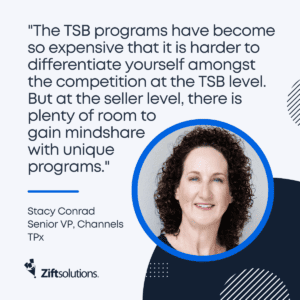
The survey for our recent blog on the best practices for a successful channel incentives program identified six essential incentive strategies to drive growth in partner ecosystems:
1. Prioritize Long-Term Incentives to Stay Competitive
Partner ecosystems should focus on long-term relationship development with select partners in a multilayered incentive approach, including:
- Loyalty incentives
- Rebates
- Universally applicable industry education
Short-term incentives, such as SPIFFs, can be effective but tend not to be a reliable point of differentiation between a supplier and their competition since all it takes is a competitor to provide a larger SPIFF to “win” short-term incentive deals from transacting partners.
2. Align Partner Goals & Supplier Goals to Inform Incentives
Alignment between vendors and their partners is critical to any incentive program. Providers should talk to their partners, look at overall business objectives and business models, verify they’re compatible and operate in tandem to reach goals following a joint business plan.
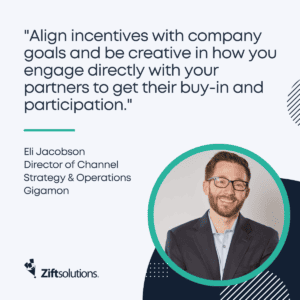
3. Design Incentive Types to Work Together
Partner programs often offer multiple incentives for partners, such as MDF, business development funds (BDF), points-based solutions, rebates, SPIFFs and more. Create a framework to combine these differing incentive types to drive toward the program’s targets. A simple example is a points-based program that incentivizes specific sales and marketing activities that are also supported by MDF and BDF.
4. Avoid Turning Incentives into Entitlements
Partner programs can easily fall into the trap of overreliance on incentives to bring in sales. In turn, partners may come to expect an incentive on every deal and interpret any incentive change as a compensation cut and stop sending deals to the supplier altogether.
5. Incentivize Roles Beyond Partner Salespeople
Partner programs commonly incentivize sales partners, yet sellers are only one of the roles in the partner organization responsible for selling and servicing the end customer account. To get organization-wide mindshare, consider compensating sales engineers, product specialists, customer service personnel and others.
6. Incentivize Pre-Sale & Post-Sale Activities
New account wins and deal closes may be a logical place to start incentivizing transacting partners, but it isn’t where your incentives should stop. Extend incentives beyond deal wins to pre-sales and post-sales activities such as marketing, training and collaboration to increase the likelihood of more new wins and retention of existing accounts.
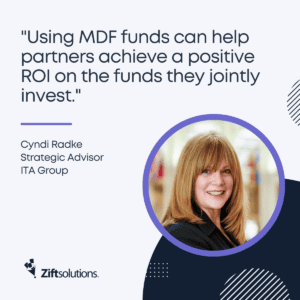
6 Steps to Create a Successful Channel Incentives Program
Beyond the best practices, our expert panel also identified six steps companies should take to create their channel incentives program.
1. Determine Sales Incentives Based on Industry Standards
One of the first items partner programs must establish in their incentives program is compensation-oriented sales incentives. “I think the competition determines much of this [compensation],” says DONO’s Sharifi. “When selling technology, there is a general range of compensation that partners expect for certain products and falling somewhere within this range is what gives your product the mindshare it needs to be more successful in the channel. Since everyone at DONO has a background in technology, we are already familiar with the ‘acceptable compensation’ range for partners. We adjusted DONO’s pricing and compensation models to be more in line with industry standards.”
Setting compensation and incentives may take some time if your products and services are new, even if you’re familiar with the expected compensation ranges for your industry. “This actually took quite a bit of time as we had to make sure our pricing made sense for the end user, based on the market, and we had to make sure it was lucrative enough for the partners who would be selling our solution,” says Sharifi. “We don’t have competition in the gifting space per se, but as a technology solution that partners can lead with, we aimed to be in the same ballpark as what other technology companies are offering.”
Industry standards can evolve over time, so make sure you’re in line with current trends. TPx’s Conrad says more incentive programs will focus on subagents who are actually selling versus the technology services brokers (TSBs) or distributors. “The TSB programs have become so expensive that it is harder to differentiate yourself amongst the competition at the TSB level,” Conrad says. “But at the seller level, there is plenty of room to gain mindshare with unique programs.”
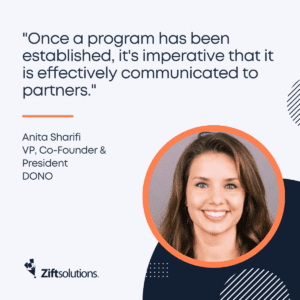
2. Match Internal Incentives to Partner Incentives
Our panel found that duplicating incentives between internal teams and external partners helps to create proper alignment up and down the sales channel. “At Gigamon, we have a channel-first strategy,” explains Gigamon’s Jacobson. “This means that if we have incentives in place internally, we extend them externally to our partner community. We’ve increased our incentives around new logo acquisition and cloud sales internally and have therefore extended those externally.”
Jacobson has found this strategy successful and his partners have vouched for it. “Per our partners, when we align our internal goals with our external incentives, it creates even more demand for our partners to proactively align with Gigamon to achieve our common goals,” says Jacobson. “Align incentives with company goals and be creative in how you engage directly with your partners to get their buy-in and participation.”
3. Use MDF to Gain Partner Mindshare & Promotion
Our panel has seen the deployment of MDF be a practical step in moving the needle with partners in ecosystem incentive programs. “Partners who take advantage of these marketing dollars, which the partner can use to market their own brand and their own events, often commit to a certain amount of sales with the company providing the MDF funds,” says DONO’s Sharifi. “This commitment gives the company an idea as to how much sales the partner is going to bring into their organization [as a measurable ROI].”
Sharifi adds that MDF is a reliable way to entice partner organizations to promote supplier solutions actively. “…[W]e know it is an effective way to get mindshare and a way to get more people ‘on your side, promoting your product’ so to speak,” says Sharifi. “The partners that we see taking advantage of these programs are heavily invested with the companies offering the MDF and are constantly striving to better themselves and increase the value they bring to their customers.”
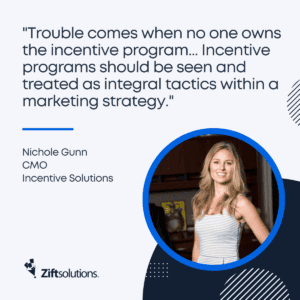
ITA Group’s Radke echoes the same sentiments around MDF providing a clear ROI for partners and providers. “Using MDF funds can help partners achieve a positive ROI on the funds they jointly invest,” says Radke.
4. Communicate Incentives Through Multiple Pathways
The experts on our panel say setting incentives and MDF are only the first step. “Once a program has been established, it’s imperative that it is effectively communicated to partners …,” says DONO’s Sharifi. “Oftentimes, communicating with partners directly will help with much of these changes.”
ITA Group’s Radke agrees, noting “clear and frequent communication” are critical for a successful incentives program.
Incentive Solutions’ Gunn puts it another way, stating that a lack of communication is often the primary challenge to successful incentive programs. Communicating program incentives can be easier said than done, as vendors must rise above the noise to gain mindshare. “Our biggest challenge is getting the word out to our partners,” says Gigamon’s Jacobson. “They are inundated with so many newsletters and emails from vendors that it’s tough for them to concentrate on a singular vendor to drive success. To work through this, we’ve increased our ’through-CAM‘ marketing and partner engagement, as well as enlisting distributors via incentive, to scale our messaging directly to partners. This grassroots, direct approach to our partner sellers [have] paid off.”
5. Assign Dedicated Personnel to Your Incentives Program
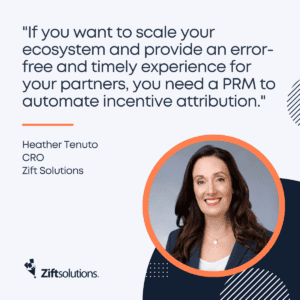 Just as partner programs have personnel dedicated to partner recruitment, onboarding, training and marketing, they also need staff responsible for incentives. “Trouble comes when no one owns the incentive program,” says Incentive Solutions’ Gunn. “We [Incentive Solutions] are service focused, so we do the heavy lifting, but programs with dedicated program managers always outperform those that do not. Incentive programs should be seen and treated as integral tactics within a marketing strategy.”
Just as partner programs have personnel dedicated to partner recruitment, onboarding, training and marketing, they also need staff responsible for incentives. “Trouble comes when no one owns the incentive program,” says Incentive Solutions’ Gunn. “We [Incentive Solutions] are service focused, so we do the heavy lifting, but programs with dedicated program managers always outperform those that do not. Incentive programs should be seen and treated as integral tactics within a marketing strategy.”
Gigamon’s Jacobson agrees on the need for dedicated incentives program personnel, primarily due to the comprehensive needs of different partner types and departments. “The operational management can be burdensome,” says Jacobson. “Having an individual or team of individuals managing and auditing is a step in the right direction for a seamless partner experience.”
6. Automate Your Incentives Program
Once you’ve determined your partner incentives, developed communications strategies and assigned management staff, you can make it easier and more scalable by automating it using a partner relationship management (PRM) software platform.
“Long gone are the days of manually tracking commissions and incentive attribution in spreadsheets,” says Zift Solutions’ Tenuto. “If you want to scale your ecosystem and provide an error-free and timely experience for your partners, you need a PRM to automate incentive attribution. Requiring partners to register deals in your PRM to qualify for incentives simplifies processes for your incentives program staff but also fulfills a key need for your C-Suite — sales pipeline and revenue forecasting, which is notoriously difficult in channel-focused organizations.”
Both fledgling and mature partner ecosystems can take these six steps to design and launch an incentives program that will produce results.




